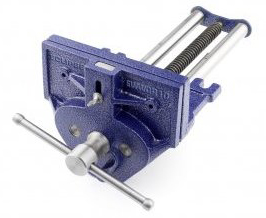|

This
series of articles
aims to serve as a general guide to the initial tool purchasing process.
One must possess some knowledge about hand tool joinery as well as experience with different projects and materials before adequately equipping a shop. All you need to know in the initial phase is that woodworking is a journey, one that will see you and your work evolve over time. With this understanding, one would do well to equip themselves not only for their current abilities, but also where they hope to improve to on that journey.
It may seem the cheaper route to purchase a more "affordable" tool, considering it a "starter." But as one improves, it will become evident that purchasing one tool twice is contradictory to the initial objective of saving money.
"Core" tools form the foundation upon which all hand tool joinery is built. The foundation of the hand tool shop is the bench, and the center piece of the bench is the vise. The bench vise sees constant use throughout every stage of the process from dimensioning to finishing. It is difficult to name a tool that is used more often or one that has a greater impact on the efficiency of other tools in a hand tool shop than the vise.
Some of what draws us to hand tools are the tools themselves. A hand saw has a certain appeal to it. Chisels and planes can be beautiful tools. Mastering these tools is an enjoyable and rewarding challenge. This endeavor need not be complicated by inadequate or improvised holding methods.
A woodworking vise differs from other types of vises. First, a woodworking vise is mounted to the underside of a bench or work surface rather than on top. This aligns the top of the vise flush with the top of your bench. The moveable jaw of the vise sometimes contains a retractable "dog" which can be raised to pinch a workpiece between it and another dog in the bench. The jaws of the vise can be made of metal or wood, and metal jaw vises should be lined with wood so work is not marred.
Some vises are equipped with a "quick-release" feature which allows the vise to be opened or closed along its entire range of motion by engaging a switch or other mechanism and bypassing the screw. This feature is especially useful for efficiency when compared to making wide adjustments by turning the handle.
Woodworking vises are referred to as "face" and "tail" or "end" vises. Face vises are attached to the face of the workbench, usually near one end of the bench. Tail vises are attached to the end of a workbench and primarily provide a method of dogging a piece along the length of the bench.
Personally, I use the
Eclipse 10" quick release vise. It is designed based on the Record 53 model vise. It has a maximum opening of 14 7/8" and while the metal jaws are 10" wide, they can be lined with cheeks that are wider than 10" to extend the width greatly if needed. The jaws of the vise are slightly toed inwards. This allows for even pressure under high clamping strength.
I have used this vise aggressively and daily for 5 years now and it still functions the way it did the day I installed it. There are several excellent options for vises by makers like
Veritas and
Eclipse
. The style comes down to personal preference and style of work, and even the style of workbench.
One consideration about the types of vises mentioned above is that they all open and close much like a drawer. There are bars and a screw beneath and between the jaws that facilitate this action. While I have not felt limited by this style, some may prefer a vise that has no obstruction beneath the jaws. In this scenario, the bench is configured in a sort of "J" shape where a single vise cheek travels the expanse created by the shape of the bench, utilizing the face of the bench or the bench apron as the other jaw. In this configuration, there is no obstruction beneath the jaws of the vise. This allows a taller workpiece to be clamped across its width. I sincerely doubt this style is a consideration for first-time vise buyers, but wanted to include the information.
While the vise may not command the appeal or marketing attention of a saw or plane, it is the epicenter of hand tool work. Assuming you have a place to mount a vise, it should absolutely be one of the first tools you buy.
If you find yourself on the fence about investing in a quality vise to begin your woodworking journey, consider the following. First, installing a vise is not a difficult undertaking but it is certainly not one you would want to repeat unless absolutely necessary. Second, if your journey is just beginning you know the least about where you will be in a year’s time or in five years’ time. While a "starter" vise may be adequate to hold a practice pin board today, will it be adequate to hold a 16/4 post dead solid while you rip your tenon cheeks tomorrow? Third, the second-hand tool market is alive and thriving and there is a steady demand for quality tools.
Lastly (and admittedly a poetic self-indulgence) simple analogs to life arise frequently in this journey. One I think of quite often is the concept that in order to shape something, you must first hold it.
Next month the series on core tools will continue with the tenon, or back saw.
Click here to learn more and purchase a bench vise for your bench
You can reach Justin by email at
justinmoon79@gmail.com
and you can also visit his website
oldlinecraft.com
|